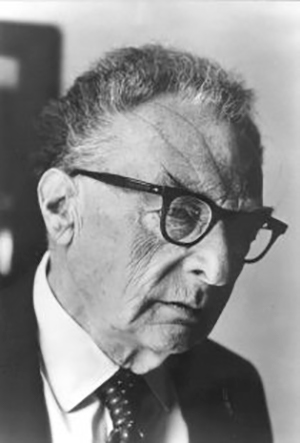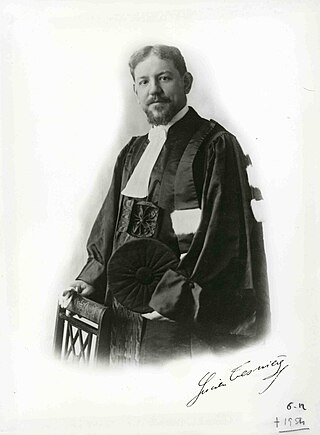Related Research Articles
The following outline is provided as an overview and topical guide to linguistics:

Roman Osipovich Jakobson was a Russian linguist and literary theorist.

Structuralism is an intellectual current and methodological approach, primarily in the social sciences, that interprets elements of human culture by way of their relationship to a broader system. It works to uncover the structural patterns that underlie all the things that humans do, think, perceive, and feel.
Semiotics is the systematic study of sign processes and the communication of meaning. In semiotics, a sign is defined as anything that communicates intentional and unintentional meaning or feelings to the sign's interpreter.
In lexical semantics, opposites are words lying in an inherently incompatible binary relationship. For example, something that is long entails that it is not short. It is referred to as a 'binary' relationship because there are two members in a set of opposites. The relationship between opposites is known as opposition. A member of a pair of opposites can generally be determined by the question What is the opposite of X ?
Russian formalism was a school of thought literary theory in Russia from the 1910s to the 1930s. It includes the work of a number of highly influential Russian and Soviet scholars such as Viktor Shklovsky, Yuri Tynianov, Vladimir Propp, Boris Eichenbaum, Roman Jakobson, Boris Tomashevsky, Grigory Gukovsky who revolutionised literary criticism between 1914 and the 1930s by establishing the specificity and autonomy of poetic language and literature. Russian formalism exerted a major influence on thinkers like Mikhail Bakhtin and Juri Lotman, and on structuralism as a whole. The movement's members had a relevant influence on modern literary criticism, as it developed in the structuralist and post-structuralist periods. Under Stalin it became a pejorative term for elitist art.
In semiotics, syntagmatic analysis is analysis of syntax or surface structure as opposed to paradigms. This is often achieved using commutation tests.
In linguistics, a syntagma is an elementary constituent segment within a text. Such a segment can be a phoneme, a word, a grammatical phrase, a sentence, or an event within a larger narrative structure, depending on the level of analysis. Syntagmatic analysis involves the study of relationships among syntagmas.

Course in General Linguistics is a book compiled by Charles Bally and Albert Sechehaye from notes on lectures given by historical-comparative linguist Ferdinand de Saussure at the University of Geneva between 1906 and 1911. It was published in 1916, after Saussure's death, and is generally regarded as the starting point of structural linguistics, an approach to linguistics that was established in the first half of the 20th century by the Prague linguistic circle. One of Saussure's translators, Roy Harris, summarized Saussure's contribution to linguistics and the study of language in the following way:
Language is no longer regarded as peripheral to our grasp of the world we live in, but as central to it. Words are not mere vocal labels or communicational adjuncts superimposed upon an already given order of things. They are collective products of social interaction, essential instruments through which human beings constitute and articulate their world. This typically twentieth-century view of language has profoundly influenced developments throughout the whole range of human sciences. It is particularly marked in linguistics, philosophy, psychology, sociology and anthropology.
In linguistics, a grammatical category or grammatical feature is a property of items within the grammar of a language. Within each category there are two or more possible values, which are normally mutually exclusive. Frequently encountered grammatical categories include:
In semiotics, the value of a sign depends on its position and relations in the system of signification and upon the particular codes being used.
In semiotics, the commutation test is used to analyze a signifying system. The test identifies signifiers as well as their signifieds, value and significance.
In semiotics, connotation arises when the denotative relationship between a signifier and its signified is inadequate to serve the needs of the community. A second level of meanings is termed connotative. These meanings are not objective representations of the thing, but new usages produced by the language group.
In linguistics and social sciences, markedness is the state of standing out as nontypical or divergent as opposed to regular or common. In a marked–unmarked relation, one term of an opposition is the broader, dominant one. The dominant default or minimum-effort form is known as unmarked; the other, secondary one is marked. In other words, markedness involves the characterization of a "normal" linguistic unit against one or more of its possible "irregular" forms.

Lucien Tesnière was a prominent and influential French linguist. He was born in Mont-Saint-Aignan on May 13, 1893. As a senior lecturer at the University of Strasbourg (1924) and later professor at the University of Montpellier (1937), he published many papers and books on Slavic languages. However, his importance in the history of linguistics is based mainly on his development of an approach to the syntax of natural languages that would become known as dependency grammar. He presented his theory in his book Éléments de syntaxe structurale, published posthumously in 1959. In the book he proposes a sophisticated formalization of syntactic structures, supported by many examples from a diversity of languages. Tesnière died in Montpellier on December 6, 1954.
One of the principal features defining traditional cinema is a fixed and linear narrative structure. In Database Cinema however, the story develops by selecting scenes from a given collection like a computer game in which a player performs certain acts and thereby selects scenes and creating a narrative.
Structural linguistics, or structuralism, in linguistics, denotes schools or theories in which language is conceived as a self-contained, self-regulating semiotic system whose elements are defined by their relationship to other elements within the system. It is derived from the work of Swiss linguist Ferdinand de Saussure and is part of the overall approach of structuralism. Saussure's Course in General Linguistics, published posthumously in 1916, stressed examining language as a dynamic system of interconnected units. Saussure is also known for introducing several basic dimensions of semiotic analysis that are still important today. Two of these are his key methods of syntagmatic and paradigmatic analysis, which define units syntactically and lexically, respectively, according to their contrast with the other units in the system.

The semiotic square, also known as the Greimas square, is a tool used in structural analysis of the relationships between semiotic signs through the opposition of concepts, such as feminine-masculine or beautiful-ugly, and of extending the relevant ontology.
The following outline is provided as an overview of and topical guide to semiotics:
Film semiotics is the study of sign process (semiosis), or any form of activity, conduct, or any process that involves signs, including the production of meaning, as these signs pertain to moving pictures. Film semiotics is used for the interpretation of many art forms, often including abstract art.
References
- Middleton, Richard (1990/2002). Studying Popular Music. Philadelphia: Open University Press. ISBN 0-335-15275-9.